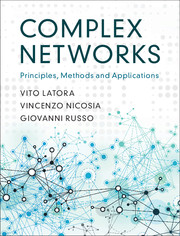Book contents
- Frontmatter
- Dedication
- Contents
- Preface
- Introduction
- Epigraph
- 1 Graphs and Graph Theory
- 2 Centrality Measures
- 3 Random Graphs
- 4 Small-World Networks
- 5 Generalised Random Graphs
- 6 Models of Growing Graphs
- 7 Degree Correlations
- 8 Cycles and Motifs
- 9 Community Structure
- 10 Weighted Networks
- Appendices
- References
- Author Index
- Index
3 - Random Graphs
Published online by Cambridge University Press: 11 October 2017
- Frontmatter
- Dedication
- Contents
- Preface
- Introduction
- Epigraph
- 1 Graphs and Graph Theory
- 2 Centrality Measures
- 3 Random Graphs
- 4 Small-World Networks
- 5 Generalised Random Graphs
- 6 Models of Growing Graphs
- 7 Degree Correlations
- 8 Cycles and Motifs
- 9 Community Structure
- 10 Weighted Networks
- Appendices
- References
- Author Index
- Index
Summary
The term random graph refers to the disordered nature of the arrangement of links between different nodes. The systematic study of random graphs was initiated by Erdős and Rényi in the late 1950s with the original purpose of studying theoretically, by means of probabilistic methods, the properties of graphs as a function of the increasing number of random connections. In this chapter we introduce the two random graph models proposed by Erdős and Rényi, and we show how many of their average properties can be derived exactly. We focus our attention on the shape of the degree distributions and on how the average properties of a random graph change as we increase the number of links. In particular, we study the critical thresholds for the appearance of small subgraphs, and for the emergence of a giant connected component or of a single connected component. As a practical example we compute the component order distribution in a set of large real networks of scientific paper coauthorships and we compare the results with random graphs having the same number of nodes and links. We finally derive an analytical expression for the characteristic path length, the average distance between nodes, in random graphs.
Erdős and Renyi (ER) Models
A random graph is a graph in which the edges are randomly distributed. In the late 1950s, two Hungarian mathematicians, Paul Erdős and Alfréd Rényi came up with a formalism for random graphs that would change traditional graph theory, and led to modern graph theory. Up to that point, graph theory was mainly combinatorics. We have seen one typical argument in Section 1.5. The new idea was to add probabilistic reasoning together with combinatorics. In practice, the idea was to consider not a single graph, but the ensemble of all the possible graphs with some fixed properties (for instance with N nodes and K links), and then use probability theory to derive the properties of the ensemble. We will show below how we can get useful information from this approach. Erdős and Rényi introduced two closely related models to generate ensembles of random graphs with a given number N of nodes, that we will henceforth call Erdős and Rényi (ER) random graphs [49, 100, 101].
- Type
- Chapter
- Information
- Complex NetworksPrinciples, Methods and Applications, pp. 69 - 106Publisher: Cambridge University PressPrint publication year: 2017



